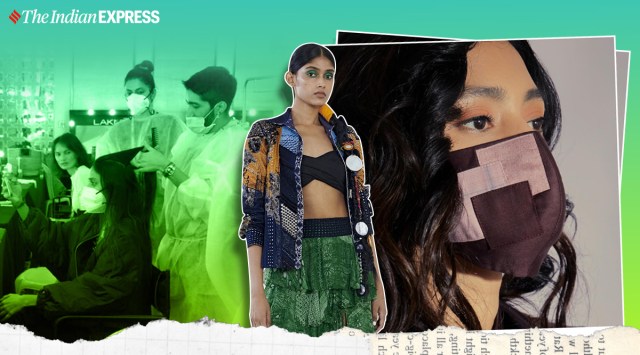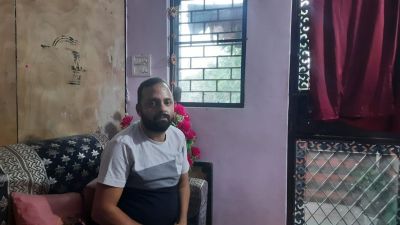- India
- International
Bespoke services, virtual shows and more: How fashion industry adapted to pandemic
Many more changes are expected, but one can’t ignore how far the industry has come in the last few months. In this article, we decode and dissect the advancements that nudged the fashion industry towards a new direction
 From virtual shows to cutting down excess, know the many changes adapted by the fashion industry amid pandemic. (Photos: Nirmooha, Saaksha & Kinni/Instagram; design: Gargi Singh)
From virtual shows to cutting down excess, know the many changes adapted by the fashion industry amid pandemic. (Photos: Nirmooha, Saaksha & Kinni/Instagram; design: Gargi Singh)Just like many other industries, the impact of the pandemic was felt by the fashion industry too. A lot has happened over the last few months, with the industry rethinking its ways of functioning, and honing survival skills amid uncertainty. While many more changes are expected, one cannot ignore the progress it has already made.
Let us decode the advancements that nudged the industry towards a new direction.
The world of virtual fashion shows
Designer Anifa Mvuemba, founder of the fashion label Hanifa, organised her first virtual fashion show in May 2020. Back home, we witnessed major virtual shows by FDCI, Reliance, and others–haute couture made its way into everyone’s houses, reversing the much-criticised exclusivity of the industry.
Designer duo Saaksha and Kinni, showstopper designers for Lakme Next Gen show this year, “couldn’t agree more”, they said. “Everybody is a front row viewer. Moreover, one does not have to travel [anymore] to watch the show; your living room is enough.”
Designer Shruti Sancheti told indianexpress.com: “2020 has changed the face of fashion temporarily, as virtual space happens to be one of the most coveted platforms to display one‘s creativity in the absence of physical shows.” She said it has “democratised the industry”, allowing everyone to be a part of the level-playing field.

While many designers love the idea of holding virtual shows, some do miss the excitement of watching models walk the ramp in their creations. “People can’t see the details on the phone screen; the attention span of the audience is also low, and what the camera shows is not depicted right — like the colours or the silhouette may not be same as they appear on-screen,” Saaksha said.
Sancheti is of the opinion that “one cannot compete with the touch and feel of actual designs, along with all the drama on the ramp and backstage.” She, however, said that while the pandemic has been a tipping point, the future of the industry will revolve around “going phygital”. “It is creating a seamless balance of physical and digital elements to showcase the collection in the new normal.”
Consumer experience
With physical shopping coming to a halt, the industry has been ensuring it continues long-standing relationships with customers through technology and bespoke services. The Lakme NextGen virtual fashion show in September introduced the concept of ‘See Now, Buy Now’, which allowed viewers to directly connect with a portal where they could discuss with designers and purchase ensembles immediately.
Designers, too, are offering to stay in contact with customers until the return of physical shopping. One such initiative is ‘Restore Love’ by Ujjawal Dubey of Antar Agni that refurbishes and reconstructs clothes according to the occasion. The brand’s initiative is backed by the idea of slowing down and consuming mindfully.
Similarly, designer Kunal Rawal, too, offers endless customization. He does this by “repurposing wedding outfits to make them wearable for other occasions”. “This is because we believe in versatility,” he said.
Recycling outfits is indeed the need of the hour not just because of the decline in purchasing power, but to be more sustainable. Rawal added: “People are looking for intricately-detailed pieces that one could make more looks out of — basically get value for your money.”
More than couture, the focus now is on producing a product that one “needs”. Rawal said, “Functionality and comfort are of prime importance for consumers these days; they only want to buy what they need now”.
Cutting down on excess for a better tomorrow
Manufacturing came to a halt in the initial months of 2020. This affected mass production and led to cutting down of waste — of which the industry was one of the major contributors. Nirmooha’s Prreeti Jaiin who has implemented a sustainable policy to ensure the surplus does not go out of control, agreed. “Recently, we started following the policy of MTO (Made To Order), where we produce only one size per style. This lessens excess production and allows us to produce designs which are solely based on orders.”
While this decision has affected Nirmooha as a brand, Jaiin said it has not stopped her from doing what is for the greater good. “By following the policy, we not only offer customization when the orders are placed but also make it a point to help consumers style a single outfit in different ways. We make sure we help clients select the most accurate styles for themselves while convincing them to not place fresh orders but to pick from the already-stitched styles,” Jaiin explained.
Designer Payal Khandwala, in an earlier interview with indianexpress.com, had raised an important question: Do we really need and want this much stuff; and how do we consolidate the two?
She added: “We need to rethink and edit a lot of the noise, which will be key to the industry that is facing its most difficult time. We need to filter this industry to make space for good, honest, sincere labels with integrity that have a purpose, versus just making more of the same stuff.”
Adios, fashion calendar
With lack of resources, lay-offs, and manufacturing coming to halt, many designers ditched their fashion calendars. From Michael Kors to Georgio Armani, and Alexander Wang to Marc Jacobs, everyone has let go of their autumn/ winter collections.
The same conversation did the rounds when Saaksha & Kinni stressed on the importance of going fluid. In an interview with this outlet, they had mentioned: “We feel it is really important as designers, as well as consumers that we just don’t shop for autumn/winter or spring/summer. It is important from a designer’s perspective to design ensembles that can be mixed and matched throughout all seasons.”
Agreeing, Kunal Rawal said that not following a calendar allowed him the “luxury of time”. “We only did two shows this year which were thought about carefully. While I am excited about spring 2021, with business and pandemic being uncertain, it has become important to be mindful and keep our expenditure in mind.”
For more lifestyle news, follow us: Twitter: lifestyle_ie | Facebook: IE Lifestyle | Instagram: ie_lifestyle
Must Read
Apr 27: Latest News
- 01
- 02
- 03
- 04
- 05




































